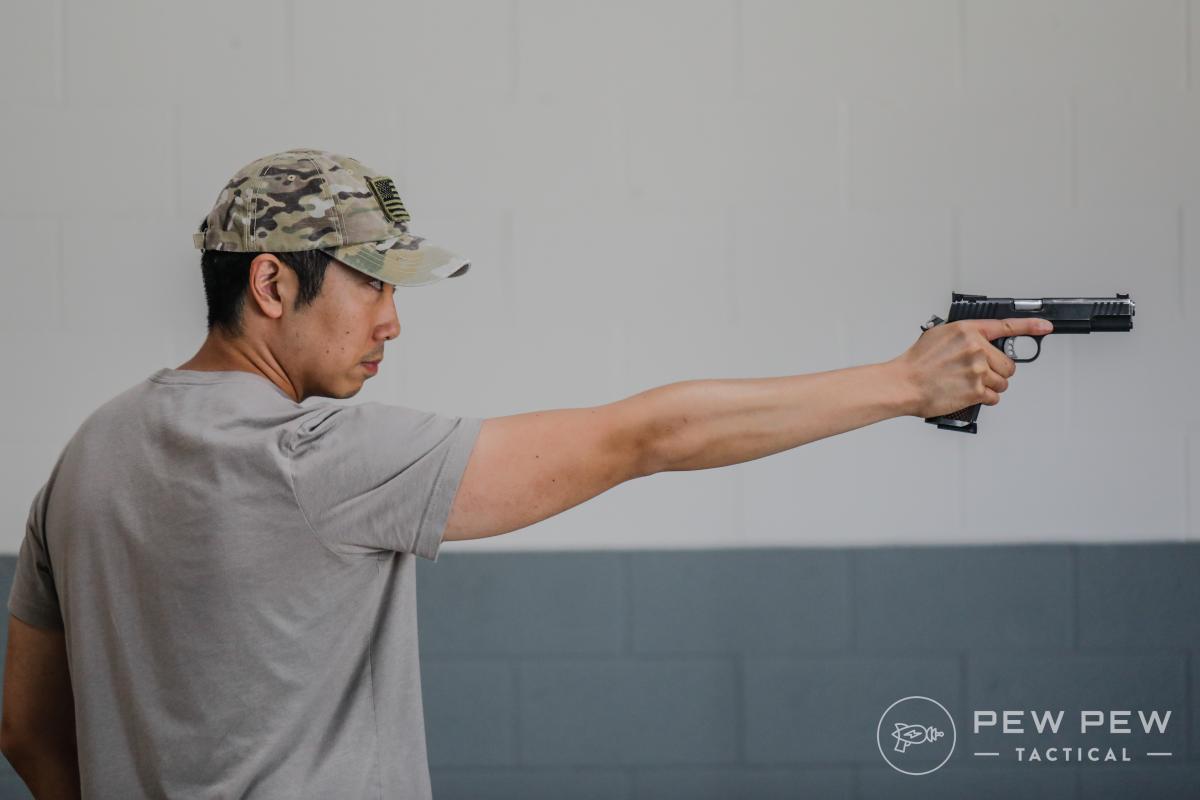I really like Pew Pew's articles. They tend to be well-written/presented and well-researched, as well as fairly complete and without much bias.
Thanks for linking this one,
@Annihilator 
-----
A couple of things that I'd like to bring up for consideration -
In the Stance portion, the author suggests that blading your body has the added benefit of allowing you to present a smaller target to your threat. While I do agree that presenting less of your body for the threat to shoot at is in and of itself is a good thing, I do not agree that
blading itself is *_always_* good. One particularly big concern with blading is the risk of taking damage to both lungs.
Additionally, he dismisses stance overall (deferring to a previous article written about what are traditionally freestyle stances), and I feel that this is an oversimplification if only for the fact that many of today's top shooters stress the importance of stance *especially* when it comes to one-handed-shooting. Remember that as we start to compromise one aspect of the fundamentals of marksmanship, we must increase our efforts in the other areas in order to mitigate/lessen the impact that compromise causes. Robert Vogel, for-instance, goes in-depth into his lower body stance and upper body presentation when he teaches his preferred single-handed technique.
Finally, while the author explores the benefit that certain gear setup (i.e. appendix) can facilitate single (particularly support-side) draw, another -potentially equally as important- consideration about gear is that having the right gear itself can sometimes help with single-handed techniques. For example, the PHLster City Special revolver holster is configured specifically to allow the insertion of the open cylinder into the holster, to assist with single-handed reloads.
-----
[
The following is pretty much the same as what I'd written in September, in @HayesGreener 's
surgery recovery thread -
https://www.thearmorylife.com/forum/threads/non-gun-hand-drills.9149/#post-114652 ]
Overall, as an average-Joe type law-abiding concealed-carry citizen, I feel very strongly that single-handed skills - both in terms of shooting/marksmanship as well as weapons manipulation - should be well-practiced. Because of the manner in which a significant portion of violent assaults may present, the I feel that we must take into consideration that we may be injured by the time we start being able to fight back.
Similarly, for those of us who are parents of younger children or whose daily life sees activities where one of our arms/hands is engaged in some other task, at the very least, the single-handed draw should be well-practiced.
One area I really liked about the article was the author highlighting that these skills should be well-rehearsed in dry-fire before live-fire is even considered. Due to the nature of these techniques, there is a very real chance of catastrophic consequences due to improper execution. I've been trying to find the original source, to no avail, but a few years ago, there was a death in a concealed-carry course because the instructor decided to show have a novice/beginner student execute a single-handed technique that they, in-retrospect, obviously wasn't ready for.
For those looking for live instruction, among others, Chris Costa's (
Costa Ludus) HET2 and CET2 offer a deep-dive into single-handed manipulations for handgun/carbine, and classes by Centrifuge Training also contain focus on single-handed considerations. Similarly, various local-level classes have sprung up as of the last 3 years or so that focus specifically on "injured shooter" techniques, and these tend to be excellent (assuming that the instructor/school is properly vetted, of-course), and can offer the chance to explore alternative techniques -or simply offer more depth- due to typically smaller class sizes (for example, techniques where the muzzle is not pointed "downrange" can rarely be explored in any other than a class that's small enough to offer individual 1:1 line time with the instructional cadre).
In terms of self-guided instructional videos, I really liked the old Magpul Dynamics "The Art of the Dynamic Handgun" materials. Unfortunately, since these videos went out-of-production, they've become somewhat of a collector's item, and now command a premium on resale sites like eBay. Nevertheless, they remain accessible on YouTube
if you search diligently enough. The late Paul Gomez's free videos are still available now on YouTube, under his tribute Channel -
https://www.youtube.com/user/Gomez8136/videos - and he had several excellent single-hand videos in that library.

 www.pewpewtactical.com
www.pewpewtactical.com

 www.pewpewtactical.com
www.pewpewtactical.com
